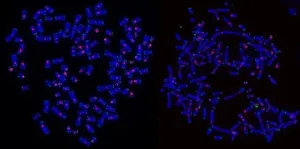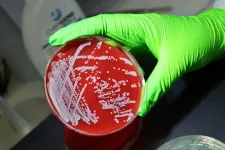(Press-News.org) The mosquito-borne Zika virus is known for causing microcephaly, a birth defect in which abnormal brain development results in a smaller-than-expected head. A new study published Jan. 13 in mBio shows that the Zika virus hijacks a host protein called ANKLE2, which happens to be important for brain development, to assist its own reproduction. Because Zika, unlike most related viruses, can cross the placenta, this can have disastrous consequences in pregnancy.
“It’s a case of Zika being in the wrong place at the wrong time,” said Priya Shah, associate professor in the departments of Microbiology and Molecular Genetics and of Chemical Engineering at the University of California, Davis and senior author on the paper.
The new work shows that related viruses, including dengue virus and yellow fever virus, also use ANKLE2 for the same purpose. The discovery could open the way to new strategies to develop vaccines or therapeutics against these viruses.
Viruses carry only a limited set of instructions in their own genetic material, so to reproduce they rely on taking over host cell proteins and functions. Shah’s laboratory studies these interactions between virus and host.
Shah and her research team previously found that a Zika virus protein called NS4A interacts with ANKLE2 in host cells. Working in Drosophila fruit flies, they showed that this could lead to microcephaly.
ANKLE2 is known to be involved in brain development in the fetus, but is found in cells throughout the body.
Forming virus factories
In the new study, led by recent Ph.D. graduate Adam Fishburn, Shah’s team grew Zika virus in human cells. Knocking out the ANKLE2 gene in these cells reduced the ability of Zika virus to grow.
In Zika-infected cells, ANKLE2 clusters in pockets around the endoplasmic reticulum, a network used for protein production within the cell.
Viral NS4A interacts with ANKLE2 to form pockets off the endoplasmic reticulum that act as virus factories, Shah said. Bringing all the components to make viruses in one place makes replication more efficient and also helps hide the virus from the immune system.
“Our current model is that ANKLE2 is really important, but not essential, for forming these replication pockets,” Shah said.
Our cells are well equipped to fight off these viruses, but only if they can find them, Fishburn said.
“Zika and related viruses have evolved strategies to hide themselves in these replication pockets to avoid detection. We believe that ANKLE2 is hijacked to help facilitate this process, and without it the pockets don’t form as well and the immune system can keep virus replication in check,” Fishburn said.
Working with Claudia Rückert at the University of Nevada, Reno, they found that Zika virus also uses ANKLE2 when it infects mosquito cells, meaning that this interaction is important in both human and insect hosts. Finally, they showed that NS4A from other, related mosquito-borne viruses, including dengue virus and yellow fever virus, interacts with ANKLE2 in the same way. This all suggests that NS4A/ANKLE2 interaction is important for replication across a broad group of mosquito-borne viruses, opening possible routes to new drugs and vaccines for these diseases.
If much more common viruses like dengue virus also target ANKLE2, why don’t they also cause the microcephaly seen in Zika virus infection? It’s probably all down to location. Zika virus is unusual in that it can cross the placenta and enter the fetus, where ANKLE2 is known to play a big role in brain development. Most other viruses are kept out of the fetus by the placental barrier.
The work was supported by grants from the National Institutes of Health and the W. M. Keck Foundation. Additional authors on the paper are: Cole Florio, Thomas Klaessens, Neil Alvin Adia, Nicholas Lopez, Nitin Sai Beesabathuni, Sydney Becker, Liubov Cherkaschenko, Sophia Haggard Arcé, Vivian Hoang and Traci Shiu at UC Davis; Brian Prince, University of Nevada, Reno; and Blake Richardson and Matthew Evans at Icahn School of Medicine at Mount Sinai, New York.
END
Wrong place, wrong time: Why Zika virus hijacks a protein needed for brain growth
2025-01-13
ELSE PRESS RELEASES FROM THIS DATE:
The new age of infrastructure maintenance using data from space
2025-01-13
The concentration of the population in cities is accelerating, and difficulties in maintaining various infrastructures are arising due to extreme weather. Extensive infrastructures like waste landfill facilities face significant challenges due to the difficulty for managers to stay on-site or access them. These maintenance issues are resulting in various problems, including environmental pollution.
To solve these issues, Korea Institute of Civil Engineering and Building Technology (KICT, President Sun Kyu, Park) has developed a cost-effective and high-efficiency maintenance technology using satellite ...
CNIO and CNIC research identifies a key protein for ‘burning’ fat
2025-01-13
This work reveals a new mechanism by which brown fat is converted into heat, and which protects from pathologies associated with obesity.
The MCJ protein is key to the fat burning mechanism now identified, making it a promising target for treating obesity, according to the authors in Nature Communications.
The research is led by Guadalupe Sabio, from Spain’s National Cancer Research Centre (CNIO), and Cintia Folgueira, from both CNIO and the National Centre for Cardiovascular Research (CNIC).
Obesity, which affects 650 ...
‘True food’ research database offers rankings for 50,000 processed foods
2025-01-13
‘True Food’ Research Database Offers Rankings for 50,000 Processed Foods
The database, developed by researchers at Mass General Brigham and made available to the public, sheds light on the availability of processed foods at different grocery stores, highlighting the need for more understanding and regulation of the foods offered
A new study by investigators from Mass General Brigham provides information to empower consumers and policymakers about the degree of processing of the foods available at three large grocery retailers. Using an algorithm, the researchers analyzed ...
Mystery solved: how tumor cells die after radiotherapy
2025-01-13
Scientists at Children’s Medical Research Institute (CMRI) have solved a big mystery in cancer research – why cells die in different ways following radiotherapy. This surprising finding opens up new opportunities to improve treatment and increase cure rates.
The findings were published in Nature Cell Biology by first author Dr Radoslaw Szmyd of CMRI’s Genome Integrity Unit, which is led by Professor Tony Cesare.
Radiation therapy (also called radiotherapy) is a critically important type of cancer treatment. Scientists have struggled for decades to understand why radiation therapy kills cells from the ...
Bacterial survival genes uncovered using evolutionary map
2025-01-13
The most detailed study to date on the mechanisms by which a common type of bacterium, Staphylococcus aureus, adapts to living on the human body could help improve the prevention, diagnosis, and treatment of certain infections.
The study, from the Wellcome Sanger Institute, the University of Cambridge, the Institute of Biomedicine of Valencia (IBV) at the Spanish National Research Council (CSIC) and their collaborators, involved using the genomes of thousands of S. aureus isolates cultured from the human nose and on the skin to investigate which genes are important for the bacteria to adapt and persist.
Published today (13 January) in Nature Communications, ...
Sodium-ion batteries need breakthroughs to compete
2025-01-13
Legions of battery engineers and their supporters have sought for years to build batteries cheaper than the dominant lithium-ion technology, hoping to capture some of lithium-ion’s $50 billion-a-year and growing market. The latest darling contender among researchers, startups, and venture capitalists – sodium-ion batteries – has received much attention after COVID-induced mineral supply chain challenges sent lithium prices on a wild ride. Still, achieving a low-cost contender may be several years away for sodium-ion batteries and will require a set of technology advances and favorable ...
Tumor DNA in the blood can predict lung cancer outcome
2025-01-13
Scientists from the Francis Crick Institute, UCL, UCLH and Personalis have found that a test to detect circulating tumour DNA can predict lung cancer outcome in a Cancer Research UK-funded study.
Circulating tumour DNA (ctDNA) is fragments of DNA released into the blood by tumours. It’s known to be important for disease prognosis but can be difficult to measure precisely.
In research published today in Nature Medicine, Crick and UCL scientists worked with Personalis to test a platform called NeXT Personal, which can detect very small amounts – 1 part per million – ...
New study unveils breakthrough in understanding cosmic particle accelerators
2025-01-13
Scientists have come a step closer to understanding how collisionless shock waves – found throughout the universe – are able to accelerate particles to extreme speeds.
These shock waves are one of nature's most powerful particle accelerators and have long intrigued scientists for the role they play in producing cosmic rays – high-energy particles that travel across vast distances in space.
The research, published today in Nature Communications, combines satellite observations from NASA’s MMS (Magnetospheric Multiscale) and THEMIS/ARTEMIS missions with recent theoretical advancements, offering a comprehensive new model ...
Previous experience affects family planning decisions of people with hereditary dementia
2025-01-13
Living in a family where there is genetic risk for dementia significantly affects choices about having children and how to parent, finds a new study led by UCL researchers.
The research, published in the Journal of Genetic Counselling, interviewed 13 people – both parents and non-parents – who are at risk of developing familial frontotemporal dementia (fFTD).
This form of dementia often begins in mid-life and is characterised by behavioural and personality changes. Children of an affected parent are at 50% risk of inheriting the gene that causes the disease.
People in affected families fall into three groups: people who don’t choose to find out whether ...
Does obesity affect children’s likelihood of survival after being diagnosed with cancer?
2025-01-13
A recent population-based study indicates that among children with cancer, those with obesity at the time of diagnosis may face an elevated risk of dying. The findings are published by Wiley online in CANCER, a peer-reviewed journal of the American Cancer Society.
The retrospective study was based on information from the Cancer in Young People in Canada (CYP-C) database, including all children with newly diagnosed cancer aged 2 to 18 years across Canada from 2001 to 2020. Obesity was defined as age and sex-adjusted body mass index at or above the 95th percentile.
Among ...





